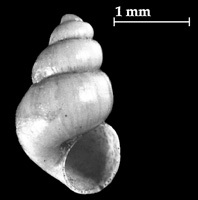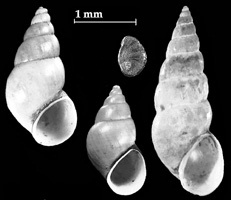Species associated with freshwater habitats

Marstoniopsis insubrica
(Küster, 1853)
The shell illustrated here
lacks its operculum.
Genus: MARSTONIOPSIS van Regteren Altena, 1936
The only species found in Britain is Marstoniopsis insubrica. It is found in still or slow-moving water in canals in the Manchester area or in lowland rivers in parts of East Anglia. It was also previously found at Grangemouth, but this colony disappeared in the 1950's.
Marstoniopsis insubrica (Küster, 1853)
Description: The shell is small, delicate and semitransparent, but the surface is usually covered by encrusting deposits. The apex is blunt and flattened, and there are 4 – 5 tumid whorls and deep sutures. The umbilicus is distinct. The aperture is egg-shaped. The body whorl forms about 65 – 70% of the height of the shell, and the aperture 40 – 45%. A yellow spot lies over each eye.
Size: Height : 2.5 mm. Breadth: 2 mm.
Habitat: On such plants as Glyceria and amongst filamentous algae in a few canal sites in Cheshire and in a few rivers in East Anglia.
Marstoniopsis insubrica was previously known as M. scholtzi (A. Schmidt, 1856). The name is changed following recent work by Falniowski & Wilke (2001) who could find no significant differences from the south alpine species M.insubrica, the name of which has priority.

Potamopyrgus antipodarum
(J.E. Gray, 1843)
Genus: POTAMOPYRGUS Stimpson, 1865
The only species found in Britain is P. antipodarum and it appears to have been an introduction from New Zealand around the end of the nineteenth century, at which time it was confined to brackish waters. It may still be found in such waters, but it has also spread inland and is now one of the most common fresh water snails throughout the country.
Potamopyrgus antipodarum (J.E. Gray, 1843)
Description: The shell is tapering, rather glossy and yellowish or light brown in colour. There are 5 or 6 whorls, which sometimes have a row of spines around the periphery. The apex is pointed and the aperture rather pear-shaped. The umbilicus is a mere chink. The final whorl forms about two-thirds of the height of the shell.
Size: Height : 4 – 5.5 mm. Breadth: 2 – 3 mm.
Habitat: Abundant in rivers, canals and streams throughout England and Wales. In Scotland it is found mainly around the north-east coastal area.
